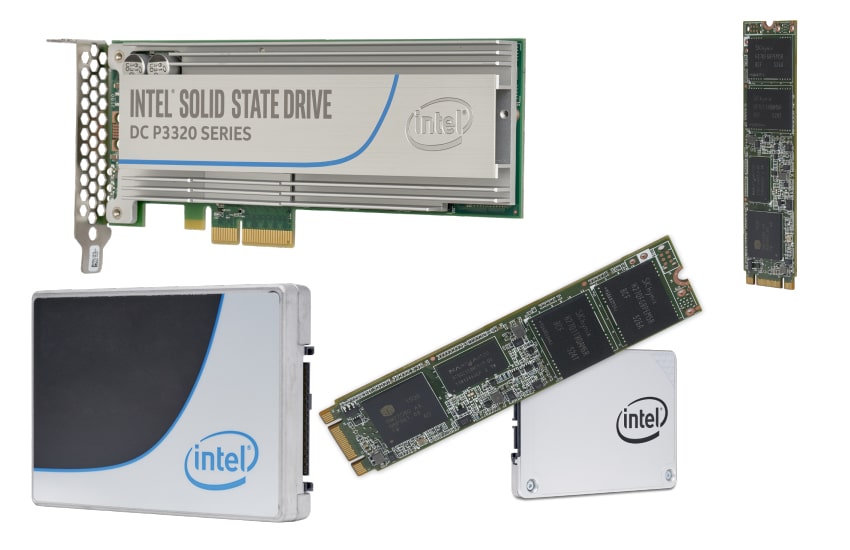 Along with releasing its latest Xeon processor series today, Intel is also expanding its portfolio of SSDs. Intel’s latest SSD are aimed at Cloud, Internet of Things (IoT), as well as consumer and enterprise Applications. The new SSDs were unveiled during Intel’s Cloud Day event today. Intel revealed several new SSDs including their first 3D NAND drive and their first dual-port PCIe SSD using NVMe protocol.
Along with releasing its latest Xeon processor series today, Intel is also expanding its portfolio of SSDs. Intel’s latest SSD are aimed at Cloud, Internet of Things (IoT), as well as consumer and enterprise Applications. The new SSDs were unveiled during Intel’s Cloud Day event today. Intel revealed several new SSDs including their first 3D NAND drive and their first dual-port PCIe SSD using NVMe protocol.
Along with releasing its latest Xeon processor series today, Intel is also expanding its portfolio of SSDs. Intel’s latest SSD are aimed at Cloud, Internet of Things (IoT), as well as consumer and enterprise Applications. The new SSDs were unveiled during Intel’s Cloud Day event today. Intel revealed several new SSDs including their first 3D NAND drive and their first dual-port PCIe SSD using NVMe protocol.

While Intel is more known for their processors, they have been making SSDs for some time as well. In fact they have some fairly impressive performers including the Intel SSD DC P3608 AIC NVMe SSD. With the latest release of their Xeon processors, Intel has increased servers compute performance. With the release of these new SSDs Intel is looking at making fast and dependable storage as well.
Intel’s new SSDs include:
- Intel SSD DC P3520 and P3320 Series – The Intel SSD DC P3520 and P3320 Series is the first Intel SSDs to use 3D NAND. The DC 3320 is designed for read-intensive applications in could and data analytics. The DC 3320 is optimized for cost-effective performance. Using PCIe Gen 3×4, the DC 3320 offers fast access to data and low latency and can deliver up to 5 times faster performance and up to 3.2 times faster sequential reads over mainstream SATA SSDs. With this performance improvement, customers can expect to see 3.45 times faster business analytics. The DC P3520 should have even better performance and lower latency over the DC P3320; it is aimed more for storage virtualization and web hosting. Intel states that these new 3D NAND offerings make the SSDs more of an affordable option when deploying multiple NVMe storage arrays that need to process large sets of data.
- Intel SSD DC D3700 and D3600 Series – The Intel SSD DC D3700 and D3600 Series are Intel’s first dual-port PCIe SSDs. These new SSDs are designed for mission-critical cloud and enterprise storage solutions that need 24x7accessibility and failover recovery. Both the D3700 and D3600 have active/active dual-port design connecting them to two hosts at once creating higher availability. These drives are Intel’s first to support NVMe specification 1.2 implementation and are all about high-availability storage, including Dynamic Multiple Namespaces Management with Reservations, scatter/gather IO list (SGL) support, consistently high IOPS and throughput with sustained low latency, power-loss data protection with self-test and thermal throttling and monitoring. Intel states that the D3700 can have up to 6 times the performance over the current dual-port SAS drives.
- Intel SSD DC S3100 Series – The Intel SSD DC S3100 Series is aimed at SMB and smaller enterprises that are looking to transition away from HDDs in their data centers. The DC S3100 series is Intel’s first TLC SATA SSD for the data center and is ideal for applications such as OS boot, edge caching and search index that require mid-level endurance, low latency and high reliability.
- Intel SSD 540s Series – The Intel SSD 540s Series is designed for several devices including Ultrabook systems, desktops, and laptops comes in both 2.5-inch and M.2 form factors and ranges in capacity from 120GB to 1TB. The 540s series delivers a low-power solution that retains Intel’s performance, quality and reliability requirements. The 540s series utilize a combination of SLC cache and TLC NAND to hit a balance of performance and value.
- Intel SSD Pro 5400s Series – The Intel SSD Pro 5400s Series is all about high performance and security. The Pro 5400s series comes in both 2.5-inch and M.2 form factors and ranges in capacity from 120GB to 1TB and supports the Trusted Computing Group’s Opal 2.0 protocol and Microsoft eDrive.
- Intel SSD E 5400s Series and Intel SSD E 5410s Series – The Intel SSD E 5400s Series and Intel SSD E 5410s Series are SSDs aimed at embedded and IoT applications. The E 5400s is targeted at applications such as smart signage, ATMs, point-of-sale devices, etc. and comes in capacities ranging from 48GB to 180GB. The E 5410s also integrate Power Loss Imminent (PLI) technology significantly reducing the possibility of data loss during a power failure. Though this is Intel’s first SSD specifically target at embedded and IoT applications they plan to continue to expand future SSD offerings to meet the specific needs of embedded and IoT applications.
Intel’s SSD Data Center Family
Sign up for the StorageReview newsletter
